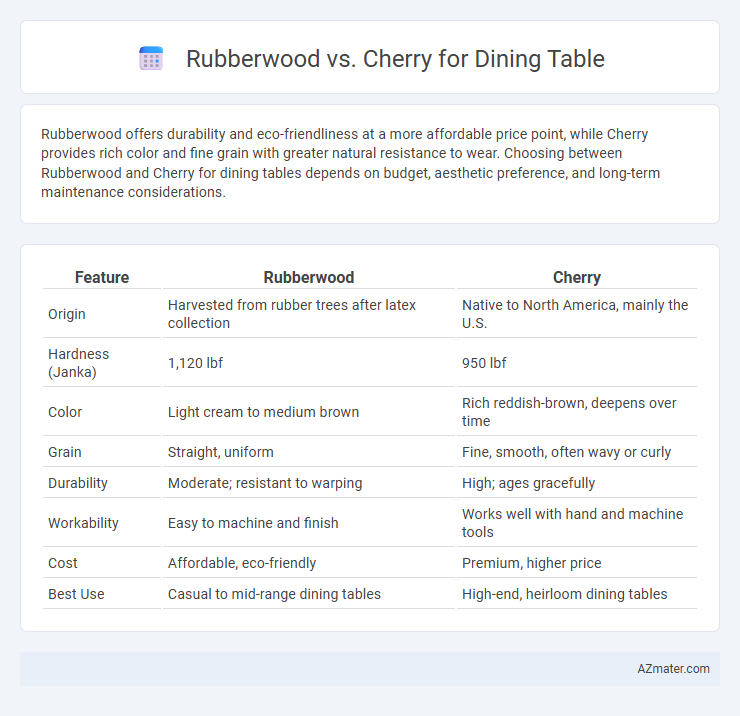Rubberwood offers durability and eco-friendliness at a more affordable price point, while Cherry provides rich color and fine grain with greater natural resistance to wear. Choosing between Rubberwood and Cherry for dining tables depends on budget, aesthetic preference, and long-term maintenance considerations.
Table of Comparison
| Feature | Rubberwood | Cherry |
|---|---|---|
| Origin | Harvested from rubber trees after latex collection | Native to North America, mainly the U.S. |
| Hardness (Janka) | 1,120 lbf | 950 lbf |
| Color | Light cream to medium brown | Rich reddish-brown, deepens over time |
| Grain | Straight, uniform | Fine, smooth, often wavy or curly |
| Durability | Moderate; resistant to warping | High; ages gracefully |
| Workability | Easy to machine and finish | Works well with hand and machine tools |
| Cost | Affordable, eco-friendly | Premium, higher price |
| Best Use | Casual to mid-range dining tables | High-end, heirloom dining tables |
Introduction to Rubberwood and Cherry
Rubberwood, derived from the Para rubber tree (Hevea brasiliensis), is a sustainable hardwood prized for its light color and durable, dense grain, making it an eco-friendly choice for dining tables. Cherry wood, sourced from American Black Cherry (Prunus serotina), is renowned for its rich reddish-brown hue and smooth texture that deepens with age, offering a luxurious aesthetic. Both woods provide distinct visual appeal and structural qualities, influencing durability and maintenance in dining table construction.
Key Differences Between Rubberwood and Cherry
Rubberwood is a sustainable, budget-friendly hardwood with a light color and moderate durability, ideal for casual dining tables, while cherry wood offers a rich, warm reddish-brown hue with excellent strength and natural aging properties, making it a premium choice for elegant, long-lasting furniture. Rubberwood's grain is relatively uniform and less prone to splintering, whereas cherry wood features a smooth, fine grain that darkens over time due to its natural oxidation process. Maintenance for cherry requires periodic polishing to preserve its luster, whereas rubberwood is more resistant to stains and easier to clean, offering practical advantages for everyday use.
Appearance and Color Comparison
Rubberwood features a light, creamy color with subtle grain patterns, offering a modern and neutral aesthetic ideal for versatile dining table designs. Cherry wood is renowned for its rich, warm reddish-brown hue that deepens over time, providing a classic, elegant appearance with pronounced grain and smooth texture. Choosing between Rubberwood and Cherry depends on desired ambiance--Rubberwood suits contemporary settings, while Cherry lends a traditional, luxurious feel.
Durability and Strength
Rubberwood offers moderate durability with good resistance to wear, making it suitable for casual dining tables, but it is softer compared to hardwoods. Cherry wood is known for its exceptional strength and dense grain, providing long-lasting durability ideal for high-use dining tables. Over time, cherry develops a rich patina and maintains structural integrity better than rubberwood under heavy daily use.
Cost and Affordability
Rubberwood is significantly more affordable than cherry wood, making it an ideal choice for budget-conscious buyers seeking a durable dining table. Cherry wood, prized for its rich color and fine grain, commands a higher price due to its hardwood density and slower growth rate. Choosing rubberwood allows for cost-effective furniture without sacrificing strength, while cherry wood offers a premium aesthetic at a premium cost.
Sustainability and Environmental Impact
Rubberwood, sourced from rubber trees no longer producing latex, offers an eco-friendly alternative by utilizing plantation timber that would otherwise be discarded, significantly reducing deforestation. Cherry wood, while prized for its durability and rich color, is often harvested from slower-growing trees, impacting forest regeneration and biodiversity. Choosing rubberwood supports sustainable forestry practices and lowers carbon footprint, making it a more environmentally responsible option for dining tables.
Maintenance and Care Requirements
Rubberwood dining tables require minimal maintenance, needing only regular dusting and occasional application of wood polish to maintain their durability and finish. Cherry wood demands more attentive care, including periodic waxing or oiling to preserve its rich color and prevent dryness or cracking over time. Both woods benefit from avoiding prolonged exposure to direct sunlight and moisture to extend their lifespan and keep their surfaces looking pristine.
Suitability for Dining Tables
Rubberwood offers excellent durability and resistance to warping, making it highly suitable for dining tables that endure daily use and varying humidity. Cherry wood, prized for its rich color and smooth grain, provides a luxurious appearance but requires more maintenance to prevent scratches and stains. Choosing between Rubberwood and Cherry depends on balancing practicality and aesthetic preferences for long-lasting dining table performance.
Pros and Cons of Rubberwood Dining Tables
Rubberwood dining tables offer a sustainable and affordable option with a pale, light finish that suits modern and minimalist interiors. The wood is durable and resistant to warping, but it tends to be softer than hardwoods like cherry, making it more susceptible to dents and scratches over time. While rubberwood requires regular sealing to protect against moisture and stains, its eco-friendly nature and cost-effectiveness make it a popular choice for budget-conscious consumers.
Pros and Cons of Cherry Dining Tables
Cherry dining tables offer exceptional durability and a rich, warm reddish-brown color that deepens with age, making them highly attractive and timeless choices for dining spaces. The hardwood's natural resistance to wear and dents ensures long-lasting use, but its higher price point and sensitivity to sunlight exposure, which can cause fading or darkening, may require careful maintenance. Unlike rubberwood, cherry furniture often develops a unique patina that adds character, though it may demand periodic refinishing to preserve its elegant appearance.

Infographic: Rubberwood vs Cherry for Dining Table
 azmater.com
azmater.com